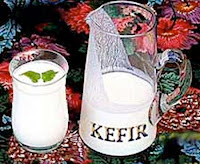
Wednesday, August 26, 2009
Guillain-Barré Syndrome

Sunday, August 16, 2009
Anti-Inflammatory Herbs, Foods, and Beverages
Sunday, August 9, 2009
My Favorite Friendly Flora Source: Kefir

My Marshmallow Fluff recipe:
3 egg whites
2 cups homemade light corn syrup substitute:
2 cups homemade powdered sugar:
Saturday, August 1, 2009
Plastic-Free Coffee Maker



Here lately I have read and heard so much bad publicity about plastics. You know what I’m talking about: the lady at work who chooses not to microwave her lunch in a plastic container ... or hearing about certain plastics breaking down or “leaching” into what is stored inside of them or onto other dishes in the dishwasher ... or remember this one, “Never freeze then thaw out your water bottles”. Yeah, there is certainly a lot of hype or skepticism out there about plastics and their safety, but how much of this should we really be concerned about? In the past, all I have really been concerned with is not to store something in a plastic container that may stain it; generally something acidic like tomatoes.
Just the other day, though, I got to thinking about the coffee maker my husband and I used to have, and how I appreciated the stainless steal lined pitcher it had. Nowadays, we have one of those fancy coffee makers with a large plastic carafe instead of the pot. My husband likes it for the convenience of being able to dispense your coffee as you need it; this is done by simply pressing your mug against a button. However, there are a lot of plastic fixtures within the coffee maker that are exposed to the coffee, which is very acidic and also "of course" very hot when brewed. We have always used regular ceramic mugs instead of plastic mugs to drink out of, but is this all the "plastic exposure" to really be aware of?
So the question came to me, “Is there such a thing as a plastic-free coffee maker?” ... and sure enough there are! There are french presses, percolators, and a little retro, but very efficient Chemex Coffee Maker! The Chemex supposedly makes coffee just as tasty as your conventional drip coffee maker; however, you do have more control over the brew because you are bringing the water to a boil in a kettle and transferring it to this lovely appliance ... and no electricity needed, which makes this coffee maker great for camping. However, you wouldn't want to place the Chemex directly on an open flame or on a burner for it is made of glass and doesn't conduct heat too well. With a percolator you can though! The percolator has always been a camping staple, and works by water seeping through the coffee grounds and leaving the coffee chamber through the bottom, dropping back into the lower half of the pot, and is then forced up the tube again. This causes the brew to continually seep through the grounds until the overall temperature of the liquid approaches boiling point. This is known as the "perking" action, which signals to you that the coffee is ready to serve. A french press requires coffee of a "coarser" grind than what is used for most drip brew coffee filters, as finer grounds will seep through the press filter and into the coffee. With the coffee grounds remaining in direct contact with the brewing water, and the grounds are being filtered from the water by a mesh instead of a paper filter, the coffee brewed with the french press captures more of the coffee's flavor and essential oils, which supposedly become trapped in a traditional drip coffee maker's paper filter. Something to think about, huh? Well to each their own. ;-)

